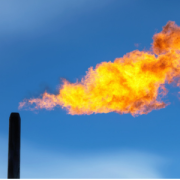In Part I of this Advisor series on reducing methane, we discussed its impact on the environment and human health as well as new developments for reducing methane emissions in agriculture. Part II covered reducing methane emissions from waste in landfills. Here in Part III, we uncover new developments for mitigating methane emissions in the fossil fuel sector.
Fossil Fuels & Methane
Fossil fuels (including those from oil, gas, and mining) are the second-largest source of global methane emissions after agriculture and contribute to about 35% of methane emissions from human-related activities. Consequently, governments and industry have made methane emissions from oil, gas, and mining operations a leading focus of their global greenhouse gas (GHG) mitigation initiatives. Key efforts include:
-
Better upstream and downstream methane leak detection and repair
-
Recovery and utilization of methane as an energy source
Detecting Methane Leaks in Oil & Gas Operations
Methane emissions can originate from various sources in oil and gas production, including intentional releases associated with flaring and venting and fugitive emissions stemming from leaky oil and natural gas wells, storage tanks, pipelines, and processing plants. Abandoned oil and natural gas wells are another problem because it can be difficult, time-consuming, and costly to identify them as potential leak sources. To meet its sustainability and environmental goals, the industry is applying advanced monitoring and inspection technology designed to quickly detect and mitigate leaks and other emissions associated with oil and natural gas operations.
Laser-Based Methane Leak Detection
LongPath Technologies has developed a laser-based system for detecting methane leaks in oil and gas operations. The laser technology underlying LongPath’s system is quite innovative. It is based on Nobel Prize–winning work done at the University of Colorado and the National Institute of Standards and Technology.
LongPath categorizes its methane-detection system as a “radar for methane.” The system is situated in a central location in an oil or gas field. A laser sends out invisible (eye-safe) beams of light and measures the amount of methane that absorbs the light. The beams are reflected back to the system’s sensors by small mirrors deployed onsite, and the amount of methane in the air is calculated based on how much of the beam was absorbed by the methane. The laser system is designed to perform continuous monitoring of methane levels in real time. This is facilitated by an automated cloud data-collection and reporting platform that can generate reports for oil and gas customers within about 30 minutes after the system has detected a methane leak.
LongPath’s system can provide wide-area coverage of many individual facilities using a single laser. Each laser deployment can cover approximately 10 square miles and up to 30 well pads (i.e., the area occupied by equipment or facilities for drilling, production, and so on at oil or natural gas wells). In this way, the system can provide continuous detection and quantified analysis of methane emissions for each site. Company reps claim the technology can reduce the time needed to locate and repair leaks from months to near real time.
LongPath’s methane-detection system is an important development for the oil and gas industry because it offers an automated means for continuous and quantitative methane emissions monitoring that is more efficient than manual leak-inspection methods. It is also cheaper than satellite methane-detection systems.
Capturing & Utilizing Methane as an Energy Source
Methane is a by-product of oil and gas operations. Historically, it was simply vented into the atmosphere or flared away as waste. Today, companies are capturing methane from oil and gas operations for use as an energy source. Typically, it is used to generate electricity, which is then used to power equipment and other infrastructure or sold to utilities providers.
A major issue with using methane as a source of power generation at oil and gas operations is that it tends to be widely distributed across various large infrastructure: well pads, pipelines, pumps, tanks, and other equipment — all of which may be located in isolated areas, including those experiencing harsh environmental conditions like offshore drilling rigs, marshes, and forests. This can require that the methane be collected, stored, and processed depending on its intended use. But what if you could use methane in unrefined form to generate power onsite at its source — for example, at the well pad or other infrastructure location?
Qnergy’s Distributed Energy Platform
Qnergy has developed what it calls a “distributed energy platform” — aptly named because it can be deployed onsite at the source of methane, which can then be use in its unrefined state. I spoke with Kevin Pang, VP of Business Development at Qnergy. He explained how the company’s “PowerGen” product is based on technology called “a linear free-piston Stirling engine.” Key points about this engine — which significantly differentiate it from internal combustion engines (ICE) — is that it can operate on almost any fuel, including unrefined methane from natural gas fields (and biogas from landfills and agricultural operations). The engine also has no rotating parts, meaning no need for regular lubrication and maintenance even when operating continuously. In contrast, an ICE requires maintenance (e.g., weekly, monthly) when used in continuous operation. These qualities make PowerGen ideal for providing power onsite even in remote and harsh environments that can be difficult to reach for servicing (see Figure 1).
Basically, PowerGen can be installed at almost any source where there is methane. It also can connect to a variety of devices requiring power, including electric-powered equipment and pneumatic devices used at isolated gas fields and legacy landfills or even digesters on farms or in kitchens and residences. This is not some unproven technology: Qnergy’s PowerGen distributed energy platform has been deployed and is operational in more than a 1,000 installations. Most of these are in the energy sector, but it is also now used to generate power at landfills and in agricultural settings. Moreover, many of these deployments operate in extreme conditions. For example, the PowerGen unit shown in Figure 1 continued to operate in Louisiana through hurricanes Laura (August 2020) and Delta (October 2020).
Qnergy uses a cloud-based Internet of Things (IoT) platform that connects PowerGen systems via cell signal and satellite access. This is used for monitoring field deployments, performing real-time analytics, and issuing reports and alerts for customers. Regarding environmental performance, a single PowerGen system can abate the emissions of about 22 tons of methane per year. This is equivalent to approximately 1,848 tons of CO2 or, put another way, getting 400 cars off the road. (PowerGen systems can also be networked to meet large energy needs.) Qnergy also offers a PowerGen-powered solution (CAP3) designed to eliminate methane emissions from the pneumatic devices powered by pressurized natural gas that are widely used in the natural gas industry for process control and other production purposes.
Conclusion
We are seeing the development of new solutions to help detect and mitigate methane emissions from operations in the fossil fuel sector. This includes the use of innovative technologies like laser-based methane-detection systems and engines for power generation that can run on unrefined methane commonly found at the source in energy-production facilities. These solutions are supported by digital platforms employing advanced analytics and IoT technologies for monitoring and optimizing methane detection and the use of methane as a power source.
The solutions discussed in this Advisor by no means represent all the developments taking place. Rather, they were covered because they are indicative of the trends and developments around the use of advanced technologies for dealing with the methane problem. Finally, I’d like to get your thoughts on the use of technology for methane reduction and other sustainability efforts. As always, your comments will be held in strict confidence. You can email me at experts@cutter.com or call +1 510 356 7299 with your comments.



